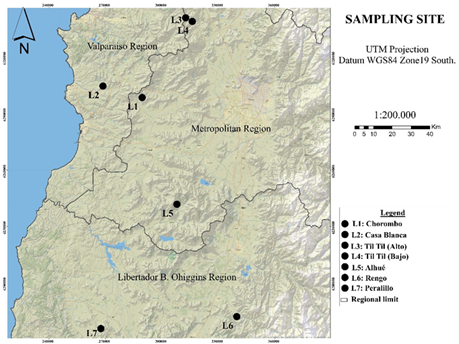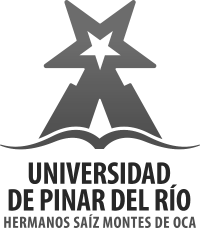Composición fenólica de Cryptocarya alba (Mol) Looser en distintas localidades y estaciones del año
Contenido principal del artículo
Resumen
La composición fenólica de diversas especies vegetales se ha estudiado para conocer cuantitativa y cualitativamente los compuestos presentes en ellas y declarar su uso como materia prima en la industria alimentaria, farmacológica, y cosmética, entre otras. En Chile hay poca información de la composición fenólica de especies vegetales nativas del bosque mediterráneo, por lo que es de gran importancia realizar estudios de caracterización fenólica para detectar cuáles son los compuestos mayoritarios, y facilitar su posible extracción o utilización de la materia prima. El objetivo de este estudio fue caracterizar y cuantificar por cromatografía líquida de alta resolución (HPLCDAD), la composición fenólica de Cryptocarya alba (Mol) Looser, en hojas y ramas jóvenes, en siete localidades de la zona central de Chile y durante las estaciones de invierno, primavera y verano. En las distintas muestras se cuantificaron los fenoles totales (FT), los taninos condensados (TC) y los fenoles de bajo peso molecular. En hojas de C. alba, para las distintas estaciones del año y localidades analizadas, se obtuvieron rangos de concentraciones de 9,8329,85 mgEAG g-1 para FT y 7,0632,00 mgEC g-1 para TC; mientras, en las ramas jóvenes, se observan concentraciones entre 0,681,61 mgEAG g-1 de FT y 1,232,53 mgEC g-1 de TC. Los compuestos fenólicos de bajo peso molecular, identificados en mayor concentración en C. alba fueron: ácido trans-clorogénico, seguido de procianidinas y flavonoles. Se concluyó que la composición y la concentración de compuestos fenólicos de C. alba varían, con la localidad y estación del año.
Descargas
Detalles del artículo
Citas
AVELLO LORCA, M., LÓPEZ CANALES, C., GATICA VALENZUELA, C., BUSTOS CONCHA, E., BRIEVA CHAIT, A., PASTENE NAVARRETE, E. y BITTNER BERNER, M., 2012. Efectos antimicrobianos de extractos de plantas chilenas de las familias Lauraceae y Atherospermataceae. Revista Cubana de Plantas Medicinales [en línea], vol. 17, no. 1, pp. 73-83. [Consulta: 21 septiembre 2020]. ISSN 1028-4796. Disponible en: http://scielo.sld.cu/scielo.php?script=sci_abstract&pid=S1028-47962012000100008&lng=es&nrm=iso&tlng=es
BATE-SMITH, E.C., 1981. Astringent tannins of the leaves of Geranium species. Phytochemistry [en línea], vol. 20, pp. 211-216. Disponible en: https://www.semanticscholar.org/paper/Astringent -tannins-of-the-leaves-of-Geranium-Bate-smith/9d83ba2e735c197194f6ac07cca90ea79c4938fd .
BINBIN, S., WENE, Z., XUE, L. & XUEJUN, P., 2017. Seasonal variations of phenolic profiles and antioxidant activity of walnut (Juglans sigillata Dode) green husks, International Journal of Food Properties, 20:sup3, S2635-S2646. Disponible en: https://www.tandfonline.com/doi/full/10.1080/10942912.2017.1381706
BRAVO, J., CARBONELL, V., SEPÚLVEDA, B., DELPORTE, C., VALDOVINOS, C.E., MARTÍNHERNÁNDEZ, R., HIGES, M., 2017. Antifungal activity of the essential oil obtained from Cryptocarya alba against infection in honey bees by Nosema ceranae, Journal of Invertebrate Pathology. vol. 149, pp 141-147. Disponible en: https://www.sciencedirect.com/science/article/abs /pii/S0022201117301532?via%3Dihub
BURLACU, E., NISCA, A., Y TANASE C., 2020. A Comprehensive Review of Phytochemistry and Biological Activities of Quercus Species. Forests. 11(9) 904-928. Disponible en: https://www.mdpi.com/1999-4907/11/9/904
CASTRO-SAAVEDRA, S.; FUENTES-BARROS, G.; TIRAPEGUI, C.; ACEVEDO-FUENTES, W.; CASSELS, B.K.; BARRIGA, A.; VILCHES-HERRERA, M. 2016.Phytochemical analysis of alkaloids from the chilean endemic tree Cryptocarya alba. Journal of the Chilean Chemical Society, 61, 3076-3080. Disponible en: https://scielo.conicyt.cl/scielo.php?script=sci_arttext&pid=S0717 -97072016000300014 .
DI COSMO, D., SANTANDER, R., URZÚA, A., PALACIOS, S., ROSSI, Y. 2015. Insecticidal effect of Cryptocarya alba essential oil on the housefly, Musca domestica L. Boletín Latinoamericano y del Caribe de Plantas Medicinales y Aromáticas 14 (2): 113 117. Disponible en: https://www.redalyc.org/pdf/856/85636183006.pdf
FARAH, A. y DONANGELO, C.M., 2006. Phenolic compounds in coffee. Brazilian Journal of Plant Physiology [en línea], vol. 18, no. 1, pp. 23-36. [Consulta: 21 septiembre 2020]. ISSN 1677-0420. DOI 10.1590/S1677-04202006000100003. Disponible en: http://www.scielo.br/scielo.php?script=sci_abstract&pid=S1677-04202006000100003&lng=en&nrm=iso&tlng=en .
GIORDANO A., FUENTES-BARROS, G., CASTRO-SAAVEDRA, S., GONZÁLEZ-COOPER, A., SUÁREZ-ROZAS, C., SALAS-NORAMBUENA J., ACEVEDO-FUENTES, W., LEYTON, F., TIRAPEGUI, C., ECHEVERRÍA, J., CLARO, S., CASSELS, B. 2019. Variation of Secondary Metabolites in the Aerial Biomass of Cryptocarya alba. Natural Product Communications. pp 1-11. Disponible en: https://journals.sagepub.com/doi/10.1177/1934578X19856258?icid=int.sj-abstract.similar-articles.2
HARRIS, C.S., BURT, A.J., SALEEM, A., LE, P.M., MARTINEAU, L.C., HADDAD, P.S., BENNETT, S.A.L. y ARNASON, J.T., 2007. A single HPLC-PAD-APCI/MS method for the quantitative comparison of phenolic compounds found in leaf, stem, root and fruit extracts of Vaccinium angustifolium. Phytochemical Analysis [en línea], vol. 18, no. 2, pp. 161-169. [Consulta: 21 septiembre 2020]. ISSN 1099-1565. DOI 10.1002/pca.970. Disponible en: https://onlinelibrary.wiley.com/doi/abs/10.1002/pca.970 .
KLEIN, FÁTIMA ROSANE S., REIS, ANDRESSA, KLEINOWSKI, ALÍTCIA M., TELLES, RENATA T., AMARANTE, LUCIANO DO, PETERS, JOSÉ A., & BRAGA, EUGENIA JACIRA B., 2018. UV-B radiation as an elicitor of secondary metabolite production in plants of the genus Alternanthera. Acta Botanica Brasilica, 32(4), 615-623. Disponible en: https://www.scielo.br/scielo.php?script=sci_arttext&pid=S0102-33062018000400615
KOVÁÈIK, J., KLEJDUS, B., BAÈKOR, M. y REPÈÁK, M., 2007. Phenylalanine ammonia-lyase activity and phenolic compounds accumulation in nitrogen-deficient Matricaria chamomilla leaf rosettes. Plant Science [en línea], vol. 172, no. 2, pp. 393-399. [Consulta: 21 septiembre 2020]. ISSN 0168-9452. DOI 10.1016/j.plantsci.2006.10.001. Disponible en: http://www.sciencedirect.com/science/article/pii/S016894520600272X .
MARQUES, V. y FARAH, A., 2009. Chlorogenic acids and related compounds in medicinal plants and infusions. Food Chemistry [en línea], vol. 113, no. 4, pp. 1370-1376. [Consulta: 21 septiembre 2020]. ISSN 0308-8146. DOI 10.1016/j.foodchem.2008.08.086. Disponible en: http://www.sciencedirect.com/science/article/pii/S0308814608010649 .
MARTÍNEZ-FLOREZ, S., GONZÁLEZ, J., CULEBRAS, J. y TUÑÓN, M., 2002. Los flavonoides: propiedades y acciones antioxidantes. Nutr. Hosp, vol. 17, no. 6, pp. 1.370-1.376. Disponible en: http://www.nutricionhospitalaria.com/pdf/3338.pdf
MEINHART AD, DAMIN FM, CALDEIRÃO L, da SILVEIRAA TFF, FILHO TJ, GODOY HT. 2017. Chlorogenic acid isomer contents in 100 plants commercialized in Brazil. Food Research International (Ottawa, Ont.). 99: 522-530. Disponible en: https://www.sciencedirect.com/science/article/abs/pii/S0963996917302697?via%3Dihub
NURMI, K., OSSIPOV, V., HAUKIOJA, E. y PIHLAJA, K., 1996. Variation of total phenolic content and individual low-molecular-weight phenolics in foliage of mountain birch trees (Betula pubescens ssp.tortuosa). Journal of Chemical Ecology, vol. 22, no. 11, pp. 2023-2040. ISSN 0098-0331. DOI 10.1007/BF02040093.
PEÑA-NEIRA, A., HERNÁNDEZ, T., GARCÍA-VALLEJO, M.C., CADAHIA, E., SIMÓN, B.F.D. y SUAREZ, J.A., 1999. Low Molecular Weight Phenols in Cork Stoppers. American Journal of Enology and Viticulture [en línea], vol. 50, no. 3, pp. 285-290. [Consulta: 21 septiembre 2020]. ISSN 0002-9254. Disponible en: https://www.ajevonline.org/content/50/3/285 .
PÉREZ-HERNÁNDEZ, L.M., CHÁVEZ-QUIROZ, K., MEDINA-JUÁREZ, L.A., GÁMEZ-MEZA, N., 2013. Compuestos fenólicos, melanoidinas y actividad antioxidante de café verde y procesado de las especies Coffea arabica y Coffea canéfora. BIOtecnia, 15(1):51. Disponible en: https://biotecnia.unison.mx/index.php/biotecnia/article/view/136
RODRÍGUEZ, R., R, R.R., J, O.M. y M, M.Q., 1983. Flora arbórea de Chile [en línea]. S.l.: Editorial de la Universidad de Concepción. Disponible en: https://books.google.com.cu/books/about /Flora_arb%C3%B3rea_de_Chile.html?id=HrZgAAAAMAAJ&redir_esc=y .
ROZEMA, J., BJÖRN, L.O., BORNMAN, J.F., GABERSCIK, A., HÄDER, D.-P., TROST, T., GERM, M., KLISCH, M., GRÖNIGER, A., SINHA, R.P., LEBERT, M., HE, Y.-Y., BUFFONI-HALL, R., DE BAKKER, N.V.J., VAN DE STAAIJ, J. y MEIJKAMP, B.B., 2002. The role of UV-B radiation in aquatic and terrestrial ecosystems—an experimental and functional analysis of the evolution of UV-absorbing compounds. Journal of Photochemistry and Photobiology. B, Biology [en línea], vol. 66, no. 1, pp. 2-12. ISSN 1011-1344. DOI 10.1016/s1011-1344(01)00269-x. Disponible en: https://pubmed.ncbi.nlm.nih.gov/11849977/ .
SAXENA, M., SAXENA, J., PRADHAN, A., 2012. Flavonoids and phenolic acids as antioxidants in plants and human health. Int. J. Pharm. Sci. Rev. Res., 16(2) nR" 28, 130-134. Disponible en: https://www.globalresearchonline.net/journalcontents/v16-2/28.pdf
SALMINEN, J-P., ROSLIN, T., KARONEN, M., SINKKONEN, J., PIHLAJA, K., y PULKKINEN, P., 2004. Seasonal variation in the content of hydrolyzable tannins, flavonoid glycosides, and proanthocyanidins in oak leaves. Journal of Chemical Ecology, 30 (9):1693-1711. Disponible en: https://link.springer.com/article/10.1023/B:JOEC.0000042396.40756.b7
SANTIBÁÑEZ, F., SANTIBÁÑEZ, P., GONZÁLEZ, P. 2016. Elaboración de una base digital del clima comunal de Chile: línea base (1980 2010) y proyección al año 2050. Informe final. Julio 2016. INFODEP. Ministerio del Medio Ambiente. Gobierno de Chile. p 99. Disponible en: http://basedigitaldelclima.mma.gob.cl/study/one
SHARMA, A., SHAHZAD, B., REHMAN, A. BHARDWAJ, R., LANDI, M. Y ZHENG, B. 2019. Response of Phenylpropanoid Pathway and the Role of Polyphenols in Plants under Abiotic Stress. Molecules. 24(13): 2452-2474. Disponible en: https://www.mdpi.com/1420-3049/24/13/2452
SOLAR, A., COLARIÈ, M., USENIK, V. y STAMPAR, F., 2006. Seasonal variations of selected flavonoids, phenolic acids and quinones in annual shoots of common walnut (Juglans regia L.). Plant Science [en línea], vol. 170, no. 3, pp. 453-461. [Consulta: 21 septiembre 2020]. ISSN 0168-9452. DOI 10.1016/j.plantsci.2005.09.012. Disponible en: http://www.sciencedirect.com/science/article/pii/S0168945205003614
`TEFÃNESCU B.E., SZABO, K., MOCAN, A Y CRIªAN G., 2019. Phenolic Compounds from Five Ericaceae Species Leaves and Their Related Bioavailability and Health Benefits. Molecules. 24(11): 2046. Disponible en: https://www.mdpi.com/1420-3049/24/11/2046
VANHOLME, R., DE MEESTER, B., RALPH, J., BOERJAN, W. 2019. Lignin biosynthesis and its integration into metabolism. Current Opinion in Biotechnology , 56:230-239. Disponible en: https://www.sciencedirect.com/science/article/abs/pii/S0958166918301435?via%3Dihub
VIKTOROVÁ, J., KUMAR, R., REHOROVÁ, K., HOANG, L., RUML, T., FIGUEROA, C.R., VALDENEGRO, M., FUENTES, L. 2020. Antimicrobial Activity of Extracts of Two Native Fruits of Chile: Arrayan (Luma apiculata) and Peumo (Cryptocarya alba). Antibiotics. 9(8), 444. Disponible en: https://www.mdpi.com/2079-6382/9/8/444
VILLARROEL, C., VÁSQUEZ, R., VILCHES, C., ARAVENA, C., BUSTOS, M. 2020. Reporte anual de la evolución del clima en Chile 2019. Dirección Meteorológica de Chile. 37p. Disponible en: https://climatologia.meteochile.gob.cl/application/publicaciones/documentoPdf/reporteEvolucionClima/reporteEvolucionClima2019.pdf
VOGEL, H., RAZMILIC, I., SAN MARTÍN, J., DOLL, U. y GONZÁLEZ, B., 2008. Plantas medicinales chilenas: experiencias de domesticación y cultivo de boldo, matico, bailahuén, canelo, peumo y maqui [en línea], 2008. S.l.: Editorial Universidad de Talca. ISBN 978-956-7059-91-1. Disponible en: https://books.google.com.cu/books/about /Plantas_medicinales_chilenas.html?id=GiDWXwAACAAJ&redir_esc=y .
WITZELL, J., GREF, R. y NÄSHOLM, T., 2003. Plant-part specific and temporal variation in phenolic compounds of boreal bilberry (Vaccinium myrtillus) plants. Biochemical Systematics and Ecology [en línea], vol. 31, no. 2, pp. 115-127. [Consulta: 21 septiembre 2020]. ISSN 0305-1978. DOI 10.1016/S0305-1978(02)00141-2. Disponible en: http://www.sciencedirect.com/science/article /pii/S0305197802001412.
ZOECKLEIN, B.W. y MACARRÓN, E.L., 2000. Análisis y producción de vino [en línea]. S.l.: Acribia. ISBN 978-84-200-0936-0. Disponible en: https://books.google.com.cu/books/about /An%C3%A1lisis_y_producci%C3%B3n_de_vino.html?id=OTwGAAAACAAJ&source=kp_book_description&redir_esc=y


